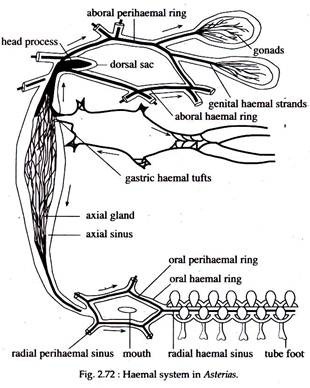In this article we will discuss about the Hemal System in Star Fish:- 1. Meaning of Hemal System 2. Haemal System in Relation to Circulating fluid in Star Fish 3. Circulation in Star Fish.
Meaning of Hemal System:
Asteroids, like other echinoderms, depend primarily on coelomic circulation for internal transport of gases and nutrients. In echinoderms, the blood vascular system is called hemal system, which is poorly developed in star fish and plays little role in circulation.
The system consists of small fluid-filled sinus-channels that lack a distinct lining. The haemal channels are actually intercommunicating spaces and are not true blood vessels. The channels are surrounded by special separate extensions of the coelom called perihaemal spaces or perihaemal system.
The haemal system includes the following parts:
ADVERTISEMENTS:
i. Oral Haemal Ring:
It proceeds in the septum of the hypo-neural sinus. It gives off radial haemal sinuses into the arms. Each arm has one radial haemal sinus which is situated in the septum of the hypo-neural radial haemal sinus and gives off branches to the tube feet.
ii. Aboral Haemal Ring:
It lies on the aboral side and gives haemal branches to the gonads (Fig. 2.72).
iii. Haemal Plexus:
The oral and aboral haemal rings communicate with each other by an ascending haemal plexus in the axial gland.
iv. Axial Gland:
The gland is variously called as ovoid gland, brown gland, septal gland or dorsal organ. It is a dark elongated mass of spongy tissue that extends along the length of the stone canal. Its lumen or the haemal plexus communicates with a small closed contractile sac called dorsal sac or terminal sac or madreporic vesicle located in the mardreporite.
ADVERTISEMENTS:
This vesicle is situated very close to the ampulla of the stone canal but has no connection with it (Fig. 2.72). The haemal plexus of the axial gland is known as heart of star fish. The function of the axial gland and its relation to other system are not clear. The histological picture reveals its similarity with the haemal system.
At the opening of the axial gland into the aboral haemal ring, two gastric haemal lacunae or tufts open into the haemal plexus of the axial gland. According to some workers, there are about twenty pyloric haemal channels which are in communication with the axial gland and haemal plexus through gastric haemal tufts.
Haemal System in Relation to Circulating fluid in Star Fish:
The colourless fluid, filling the haemal system is often referred to as blood. The haemal system has direct communication with coelomic cavities. To what extent, the chemical composition of the blood of sea-star differs from those of coelomic fluid is debatable, due to lack of relevant chemical data. However, body wall of sea star are freely permeable to sea water and their perivisceral fluid is similar to sea water in ionic composition.
In Asterias forbesi, the perivisceral fluid contains amino nitrogen, a small amount of reducing sugar and excretory products like ammonia and urea. Among coelomocytes, phagocytes are abundantly present in the coelomic fluid of star fish.
Haemal System in Relation to Circulation in Star Fish:
The heart beats rhythmically, about 6 beats per minute in A. forbesi, but the pattern of circulation is not properly known. Contractility of the gastric haemal tufts and aboral haemal ring has also been observed by some workers. There are also evidences that the hemal system is the pathway for the distribution of food materials to different parts of the body, carried by the coelomocytes.
So it is reasonable to conclude that various pulsatile and contractile parts of the haemal system may be significant in this connection that these may serve not as components of an ‘efficient blood vascular system’, but as mechanisms bringing about the mixing of fluids and promoting the exchange of materials between them.
